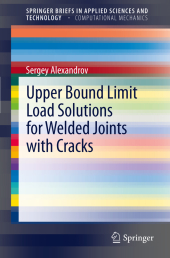 Neuerscheinungen 2012Stand: 2020-01-07 |
Schnellsuche
ISBN/Stichwort/Autor
|
Herderstraße 10
10625 Berlin
Tel.: 030 315 714 16
Fax 030 315 714 14
info@buchspektrum.de |

Sergey Alexandrov
Upper Bound Limit Load Solutions for Welded Joints with Cracks
2012. 2012. ix, 117 S. 65 SW-Abb. 235 mm
Verlag/Jahr: SPRINGER, BERLIN 2012
ISBN: 3-642-29233-X (364229233X)
Neue ISBN: 978-3-642-29233-0 (9783642292330)
Preis und Lieferzeit: Bitte klicken
The present short monograph concerns analytic and semi-analytic techniques for finding an approximate value of the limit load. The limit load is an essential input parameter of flaw assessment procedures. In most cases, finding the limit load involves some numerical calculations of different levels of complexity, including numerical minimization of functions of one or several arguments, the slip-line technique and the finite element method. This book shows in particular how to use singular behavior of the real velocity field in the vicinity of bi-material interfaces in kinematically admissible velocity fields to increase the accuracy of upper bound solutions. An approach to recalculate the limit load for a class of structures with defects with the use of its value for the corresponding structure with no defect is discussed. The upper bound technique is applied to evaluate the limit load of overmatched and undermatched welded joints with cracks subject to various loading conditions of practical importance in conjunction with the aforementioned special techniques.
Upper Bound Theorem.- Isotropic Materials.- Highly Undermatched Joints.- Overmatched Joints.- Anisotropic Materials.- Highly Undermatched Joints.- Overmatched Joints.- Concluding Remarks.
From the reviews:
"This monograph describes how to apply the upper bound theorem to find the limit load for welded structures with cracks. The presentation contains introductory material and advanced developments, and is divided into six chapters. ... The monograph will be useful to engineers and graduate students interested in the limit load solutions, and could also be useful to applied mathematicians." (Prabhat Kumar Mahanti, Zentralblatt MATH, Vol. 1257, 2013)


